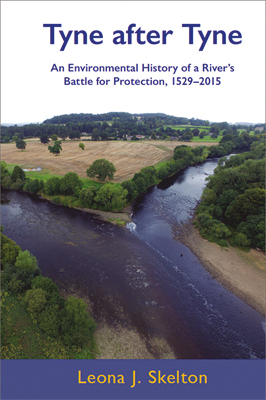Tyne after Tyne
An Environmental History of a River’s Battle for Protection 1529–2015

Leona J. Skelton
PEOPLE AND THE TYNE: 500 YEARS OF NEGOTIATION
Over the last five centuries, North-East England’s River Tyne went largely with the flow as it rode with us on a rollercoaster from technologically limited early modern oligarchy, to large-scale Victorian ‘improvement’, to twentieth-century deoxygenation and twenty-first-century efforts to expand biodiversity. Studying five centuries of Tyne conservatorship reveals that 1855 to 1972 was a blip on the graph of environmental concern, preceded and followed by more sustainable engagement and a fairer negotiation with the river’s forces and expressions as a whole and natural system, albeit driven by different motivations. Even during this blip, however, several organisations, tried to protect the river’s environmental health from harm.
This Tyne study offers a template for a future body of work on British rivers that dislodges the Thames as the river of choice in British environmental history. And it undermines traditional approaches to rivers as passive backdrops of human activities. Departing from narratives that equated change with improvement, or with loss and destruction, it moves away from morally loaded notions of better or worse, and even dead, rivers. The book fully situates the Tyne’s fluvial transformations within political, economic, cultural, social and intellectual contexts. With such a long view, we can objectify ourselves through our descendants’ eyes, reconnecting us not only to our past, but also to our future.
Let us sit with the Tyne itself, some of its salmon, a seventeenth-century Tyne River Court Juror, some nineteenth-century Tyne Improvement Commissioners, a 1920s biologist, a twentieth-century Tyne angler, shipbuilder and council planner and some twenty-first-century Tyne Rivers Trust volunteers. Where would they agree and disagree? How would they explain their conceptualisation of what the river is for and how it should be used and regulated? This book takes you to the heart of such virtual debates to revive, reconnect and reinvigorate the severed bonds and flows linking riparian places, issues and people across five centuries.
LOOK INSIDE THIS BOOK at Amazon.co.uk
THE AUTHOR
An environmental historian of water, rivers and sanitation infrastructure, Leona J. Skelton is Vice Chancellor’s Research Fellow in the Humanities at Northumbria University in Newcastle. Her work focuses on the two-way interactions between people and the environment, developments in environmental attitudes and regulation and how dramatic environmental change has shaped economic, cultural and social lives and livelihoods across northern England and Scotland between 1500 and the present day. Her first monograph was Sanitation in Urban Britain, 1560-1700 (London: Routledge, 2015). Between 2012 and 2015, she contributed to two of Prof. Peter Coates’ Arts and Humanities Research Council-funded environmental history research projects as a Research Assistant: ‘The Places that Speak to Us and the Publics we Talk with’ and ‘The Power and the Water: Reconnecting Pasts with Futures’.
‘Tyne after Tyne is an excellent book which warrants a broad readership. The book will be of interest not only to river historians and those with a specific interest in Northeast England, but to historians, and especially environmental historians, more broadly. The broad time-sweep taken within the book is of value to those wishing to trace environmental concerns more generally, whilst the methodological insights and conceptual arguments offer a useful blueprint for future historical scholarship.’
Mark Riley – Environment and History
‘… tracks the changing meanings of conservation alongside the changing set of conservators who managed and utilized a river that increasingly turned into an economic system.’
Elizabeth Hameeteman – Environmental History
‘Tyne after Tyne is an interesting and welcome addition to the field of river history.’
Leslie Tomory – H-Net
CONTENTS
Chapter 1. ‘Hurting the River of Tine’: Protecting a Pre-Modern River Estuary, 1529–1850
Chapter 2. ‘Tinkering’ the Tyne: Increasing Demand for Structural Change, 1655–1855
Chapter 3. Creating a Grand and Deep River: The Tyne Improvement Commission, 1850–1968
Chapter 4. Fish in the Tyne: The Tyne Salmon Conservancy, 1866–1950
Chapter 5. Testing the Troubled Waters: SCORP’s Tyne Sub-committee and a Succession of Unsuccessful Reports, 1921–1945
Chapter 6: ‘A Medieval Street of Squalor’: The Final Demand for a Clean-Up, 1950–1975
Chapter 7. Damming the Tyne: The Creation and Impact of Kielder Reservoir, 1975–2015
Chapter 8. ‘A Big River?’: Regeneration, Tourism and the Cultural Meaning of the Tyne, 1972–2015
Publication date, 1 March 2017 (paperback 9 April 2021). 256 pp.
ISBN 978-1-874267-95-9 (HB) £65
ISBN 978-1-912186-25-9 (PB) £27
